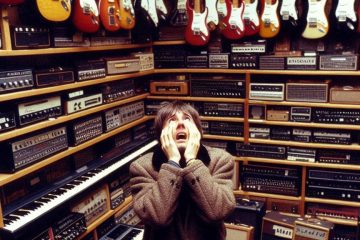I started out learning guitar when I was 10. I learnt for 6 – 12 months and thankfully got a foundation through A Modern Method for Guitar – Volume 1 (I highly recommend this book for guitarists of all levels).
It wasn’t until I was studying music composition that I was exposed to synthesisers. I remember being in a weekly composition workshop and being shown the principals of synthesis on a Roland MKS-80 Super Jupiter with an MPG-80 programmer. I also remember pressing a button and asking what it did and the tutor looking at me incredulously as he told me it resets everything he just did … I was 19 years old at the time.
More recently I’ve been diving back into the world of synthesis more seriously. I’ve bought some desktop synths and been digging into some new soft synths and what I’ve learned is you need to know your sounds and better still how to get your sounds from the basic building blocks of synthesis.
The world of guitar has a myriad of amps and effects that can be applied but you have that fundamental foundation of a guitar that you’re building from. Synths on the other hand create their sonic palette in a far more complex fashion and building a sound requires an intimate knowledge of synthesis style.
You’ve got FM, subtractive (analog), wavetable, additive synthesis etc to start with. Then each hardware or software synthesiser will have options to manipulate these foundational methods of synthesis.
I am a novice in this regard but it’s a fascinating learning experience.
The thing that struck me (and the purpose of this post) is that unlike a guitar where I will find it much easier to find a sound quickly, synthesisers are like having a room full of exotic instruments at your disposal. You really need to spend time getting an idea of their sounds and sonic abilities if you want to work quickly and efficiently as you are song writing and producing a track.
I know that might seem like a “ya think?” type statement but for me it is a glaring hole in my production abilities that I want to fill.
The Takeaway: As a painter gains a deeper understanding of colours and colour theory it gives them the knowledge to choose palettes to execute artworks that have the impact and nuances of a true artisan. Likewise, as music producers, learning sounds and understanding how to achieve them gives us the sonic palette to craft more impactful and nuanced music. It’s worth spending time in play as well as understanding the theory of each type of synthesiser you are using to better understand the palette of colours you’re working with.



0 Comments